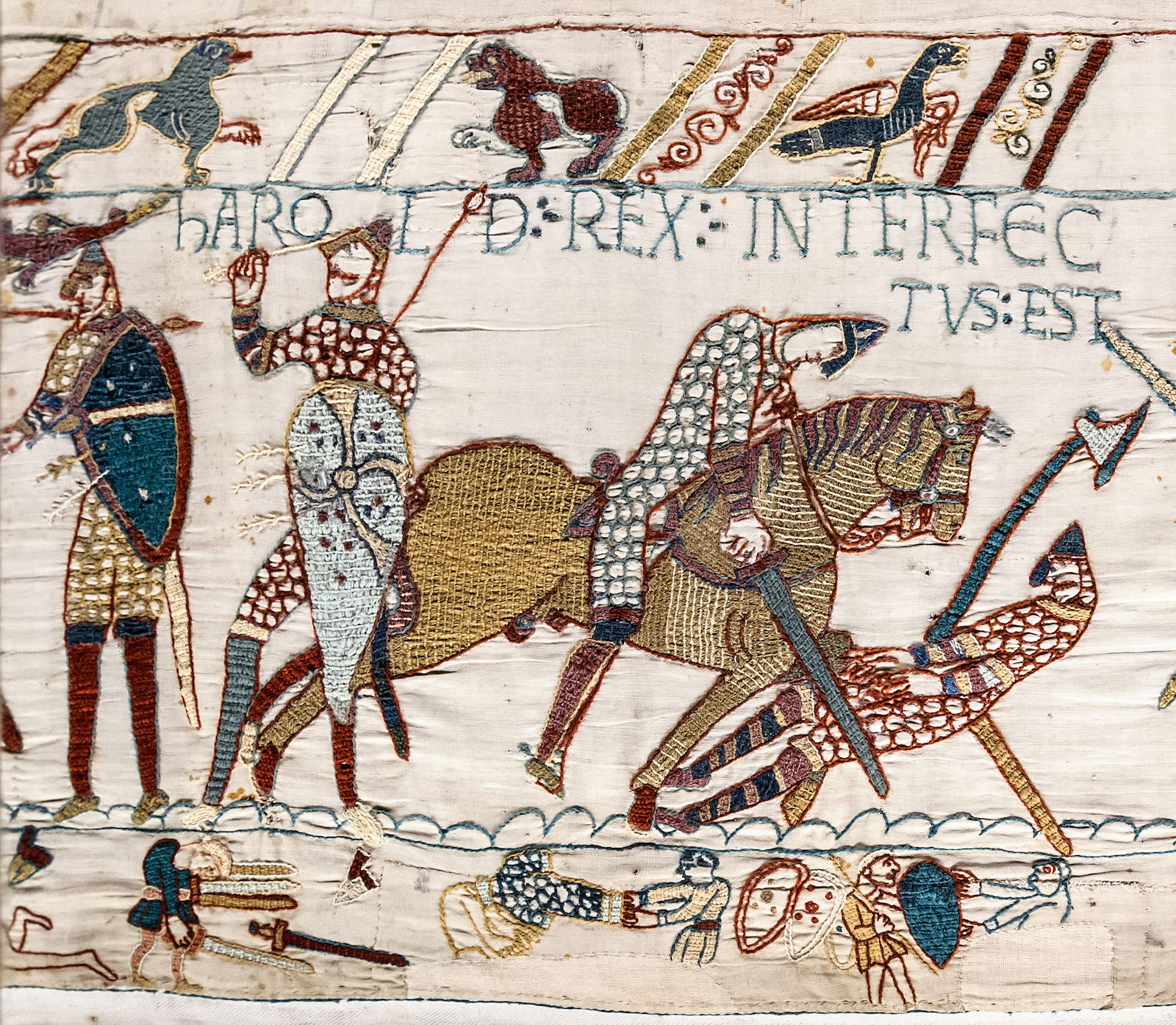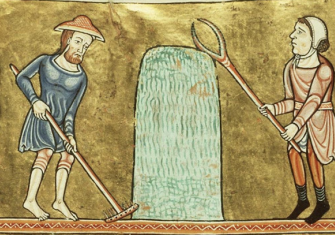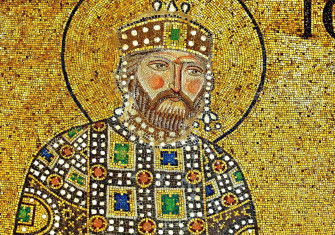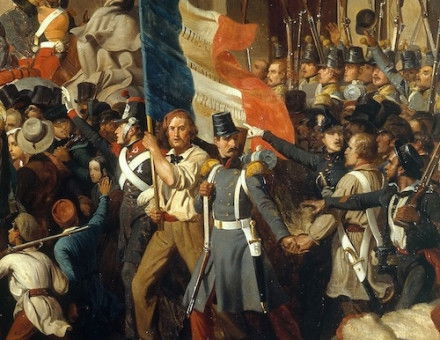King Harold: Shot through the Eye and Who’s to Blame?
Unpicking a tangle of history, myth and misunderstanding reveals why, for so long, we believed King Harold was shot through the eye at the Battle of Hastings.

Harold’s death at Hastings by an arrow to the eye remains one of the most enduring ‘facts’ in English history. But this detail may have been the product of historians writing generations after 1066 and the Bayeux Tapestry, the most famous witness to Harold’s death, may not show the king being shot by an arrow at all.
Accounts from the years immediately following Hastings make no mention of an arrow when describing Harold’s death. Most only note the bare fact that the king died in battle or, as an early Norman historian puts it, that he fell, ‘pierced with mortal wounds’. One early Norman history, the Carmen de Hastingae Proelio (‘Song of the Battle of Hastings’), does provide a more detailed account of Harold’s demise, reporting that William and three French knights broke through the English defences at the top of a hill, where they literally took Harold apart:
The first of the four, piercing the king’s shield and chest with his lance, drenched the ground with a gushing stream of blood. The second with his sword cut off his head below the protection of his helm. The third liquefied his entrails with his spear. And the fourth cut off his thigh and carried it some distance away.
This tradition that Harold died by being hacked into pieces reappears in many accounts throughout the period. So where does the legend of the arrow come from and is it rooted in historical fact? William of Poitiers, another early Norman chronicler (c.1077), notes the effectiveness of the French archers against English defences, a detail also included in the borders of the Bayeux Tapestry. Some scholars point to an early Italian chronicler, Amato di Montecassino, who wrote a history of the Normans just after the Conquest (c.1080) that reports that, when William fought Harold, he ‘gouged out his eye with an arrow’. But this account is suspect: it only survives in a French translation of the original, written almost 250 years after Hastings, and the translator has mixed in a number of additions and exaggerations to the text.
Four decades after Hastings, the French bishop Baudri of Bourgueil wrote a long poem dedicated to Adela of Blois, one of William the Conqueror’s daughters. In it he describes Harold dying by a laetalis arundo (‘a lethal arrow’). Baudri, a writer fond of classical allusion, may have taken the phrase directly from Virgil’s description of a heartbroken Dido wandering like a deer pierced by a deadly shaft. A few decades later, the English historian William of Malmesbury (similarly disposed to quote the classics) uses this exact phrase again, but crucially elaborates that the arrow pierced Harold’s brain and then he was hacked at by a knight as he lay on the ground.
Two other 12th-century accounts helped to fix the story in the popular and historical imagination for centuries to come. The English historian Henry of Huntingdon reports that a shower of Norman arrows fell around Harold and one ‘struck him in the eye’. And the Norman chronicler Wace relates that during the battle an arrow grievously wounds the king ‘above the right eye’. Harold pulls it out, but then so many Norman knights attack him that Wace cannot say truly who killed the king.
Made only a few years after 1066, the Bayeux Tapestry is often considered the earliest and most convincing evidence that Harold was killed by an arrow to the eye. In the final battle scene the inscription reads: ‘Here King Harold is killed’ (Hic Harold rex interfectus est). The Anglo-Saxon shield wall on the left is breached by a charging Norman horseman, cutting down a falling Englishman holding an axe – indisputably identified as Harold – at the centre of the action. However, immediately behind the breached wall, the standing figure with his fist raised has also been identified as Harold. Are there two Harolds in the scene? The case appears easy to make: the word ‘Harold’ breaks around the standing figure’s head and, of course, he appears to be pulling an arrow out of his head. This neatly aligns with the later narratives, where Harold is first struck by an arrow and then killed by Norman cavalry. It is even possible that Wace, who held religious office in Bayeux, could have seen and used the Tapestry itself as a source.
But a closer look at the form and history of this scene muddies the water. In other Tapestry scenes with long inscriptions, names are often not close to the figures they represent. In the earlier scene of Harold’s oath to William, for instance, Harold’s name appears over William’s head. And in Harold’s death scene, the arrow of the figure in question is not original, but was added during 19th-century French repairs; 18th century reproductions show this soldier holding a spear shaft above his head. Not until Charles Stothard’s 1818 watercolour of the Tapestry is it reconstructed as an arrow and not a spear. The modern stitchwork not only turns the shaft into an arrow but actually lowers its angle as it runs behind his head.
It is possible that conservators altered the textile’s content to fit later medieval literary traditions. During the 19th century, some scholars believed the Tapestry dated from the 12th century and that Wace’s account was itself the source for the embroidery’s visual narrative. For example, Wace describes the effectiveness of the Norman archers, writing that their ‘falling arrows struck heads and faces, and put out the eyes of many; and all feared to open their eyes, or leave their faces unguarded’. A close study of the embroidery’s stitching and pre-repair engravings reveals that at least seven modern arrows striking figures have been added – all distinctly longer than their medieval counterparts. Such historical revision may also explain one final mystery of the Tapestry: the 17 empty stitch-holes now running in a straight line from the head of the falling Harold in the centre of the scene. Did restorers add one more arrow here and was it then removed because it contradicted Wace’s report that Harold pulled the arrow out of his eye before he was killed?
Martin Foys is a Professor of English at the University of Wisconsin-Madison. He is the author of The Bayeux Tapestry Digital Edition (SDE, 2003) and an editor of The Bayeux Tapestry: New Interpretations (Boydell and Brewer, 2009).






